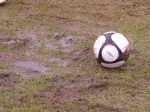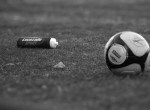Lyon
Leave a commentFC Olympique Lyonnais – Stade de Gerland -Capacity – 41,184 All Seater
 The Stadium – Stade de Gerland
The Stadium – Stade de Gerland
350 Avenue Jean Jaurès, Lyon 69007
The Stade Gerland has been home to the club since the end of World War One – in fact most of the original stadium was actually built by German PoW’s at the end of the conflict. Originally it was a multi-purpose venue, hosting athletics and cycling with a capacity of over 50,000. In 1984 the stadium hosted two games in the European Championships, including the semi final between Denmark and Spain in front of over 47,000.
In preparation for the 1998 World Cup Finals, the athletics track was removed from the stadium, and the terracing replaced with seats, reducing the capacity to 42,000. The stadium hosted six games at the Finals including the historic meeting between USA and Iran, and France’s game versus Denmark. It was also chosen as one of the hosts of the 2003 Confederations Cup Tournament, and was the venue for the ill-fated game between Cameroon and Columbia when former midfield star Marc-Vivien Foé collapsed and died.
The venue has recently been chosen to host games in the 2007 Rugby World Cup, including a New Zealand All Blacks and an Australian Wallabies game. The stadium features some classic architecture that has lead to parts of the ground being listed. These include the entrance archways and the main stand façade. The views from all parts are very good, and if possible games against local rivals St Etienne or Paris Saint Germain are very lively affairs.
Who Plays There?
Olympique Lyonnais, or simply OL, represent the new world order in French football after securing their fifth successive league title in 2006. The turnaround in their fortunes has been remarkable – as before 2002 their only honour had been a couple of French Cup Victories in 1964 and 1967. In fact it wasn’t until the early 1990’s that the team became firmly established in Ligue 1.
The club as we know it today was formed in 1950 as Lyon Olympique Universitaire, and they soon started on the road to success with a Ligue 2 title in 1951. No further success came until the 1960’s when the club managed to beat Bordeaux in 1964 and Sochaux in 1967 to take the Coupe de France. In 1983 the team found themselves back in Ligue 2. During the next few years the club was sold to Jean-Michel Aulas who vowed to the fans to deliver European football within 3 years to the club. One of his first moves was to appoint current French national coach Raymond Domenech, who wasted no time in getting the club promoted back to the top league.
Within two years Domenech had guided the club to fifth place which meant they qualified for the UEFA Cup – as promised by Aulas. Over the next few years a series of high profile coaches were employed to try and fulfil the next stage in Aulas’s dream – the delivery of the Ligue 1 title. These included Jean Tigana, Bernard Lacombe and Jacques Santini. It was Santini who finally delivered Champions League football to Lyon in 2002 when the club finished as Runners Up, and a year later they claimed their first title.
Santini was replaced by current Glasgow Rangers manager Paul Le Guen who commenced a plan to make Lyon one of the dominant teams in Europe. The club were accepted as the only French team in the G-14 powerbase, a massive feather in their cap over the so called bigger teams such as PSG. Their best performance in the Champions League came in 2004 when the team won their Group, beat Real Sociedad before falling to eventual winners Porto in the Quarter Finals. Last season the team again set an astonishing pace in the domestic leagues as well as waltzing through their Champions League group. In the 2nd round they convincing beat Werder Bremen on aggregate 10-2, before losing again in the Quarter Finals on penalties to PSV Eindhoven. New coach Gerard Houllier has continued the success of the team, with the likes of Sylvain Wiltord, Gregory Coupet and the Brazilian pairing of Juninho and Fred capturing a fifth successive title in May 2006.
Again in the Champions League the Quarter Final proved to be a bridge too far, with defeat in the San Siro against AC Milan scant reward for some of Europe’s most attacking football. The current squad is built on a core of young French talent, and under Houllier they continue to play attacking football. They started the season in great form, dropping just two points from their first 9 games and recording three wins out of three in the Champions League including their almost annual victory over Real Madrid, and eventually went out to winners Manchester United in the knock out stages.
They had to wait until the last game of the season to wrap up a 6th consecutive title, holding off a strong challenge from Bordeaux. After losing Tiago,Abidel and Malouda many thought the team would struggle but thanks to the goals of Benzema they won the league and the cup beating PSG in extra time.
How to get to the Stade Gerland
The stadium is based in the south east of the city and is served by its own Metro stop at the end of line B – surprisingly called Stade de Gerland. From the centre of the old town in Perrache, go north on Line A two stops to Bellecour, then change to the eastbound Green Line D for two stops, changing onto Blue Line B for four stops at Saxe-Gambetta.
From the main station at Part-Dieu you can just head south on Line B for five stops. You can also catch bus number 96 from Perrache for the stadium.
To get an overview of who plays where in Lyon, Go to Footiemap.com to view their website page on Lyon.
How to get a ticket for the Stade Gerland
Most games go on sale on the website (http://www.ticketnet.fr) around a month before the games. These tickets can be posted to the UK or collected from the stadium ticket office in Lyon. Tickets range in price from €45 in the lower tiers behind the goals, to €60 in the Jean Bouin or Jean Jaures stands along the side of the pitch. A good seat for the neutral is in the €40 seat in the Jean Jaures lower tier. Tickets for League Cup matches are around 20% cheaper. Tickets for Champions League games are slightly more expensive than normal league games – €20 to €70.
Tickets can also be bought from the Club Shops (Planet ‘OL) in the city centre and at the stadium, Auchan and Virgin megastore. You can also book tickets by phone at 39 69 from any phone in France.
Getting around
Lyon is a big city, but is best explored on foot – especially the old town on the west of the rivers. It does have a good local transport infrastructure though, with buses, metro and trams criss-crossing the city. The Lyon City card gives unlimited public transport travel, as well as free entry into most of the city’s museums and monuments.
Nearest Airport – Lyon Saint-Exupèry (LYS)
Telephone: +33 426 007 007
Website: http://www.lyon.aeroport.fr
The airport is located 20 km to the east of the city and is the major transport hub for the Rhône-Alps skiing area. It used to be known as Satolas airport, but was renamed in 2000 in honour of local aviation pioneer Antoine de Saint-Exupéry. The airport served more than 6.5million passengers in 2005, and is set to grow with the direct tramway link to the city centre, which is due to open in 2008. Currently the best way to reach the airport is via a half hourly bus that runs to Port Dieu and Perrache stations, with a journey time of 45 minutes. The airport also has a high-speed rail link served via the TGV trains en-route from Paris to Marseille. In fact, Paris is actually accessible in less than 2 hours.
The airport is currently served by Easyjet from London Stansted, British Airways from London Gatwick, BA Connect from Birmingham and Manchester and Air France from London Heathrow. Ryanair fly to Grenoble, calling it Grenoble Lyon on a daily basis from London Stansted, East Midlands/Nottingham, Liverpool and Glasgow Prestwick. From here a coach meets inbound flights and for €20 one way or €30 return you can be in Lyon Part Dieu within an hour.



 .
. .
. .
. .
. .
. .
. .
. .
. .
. .
.